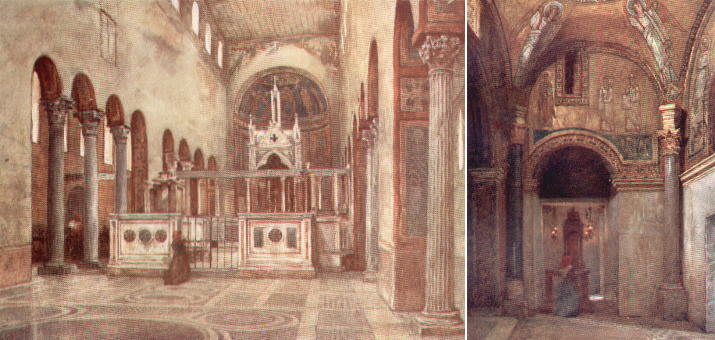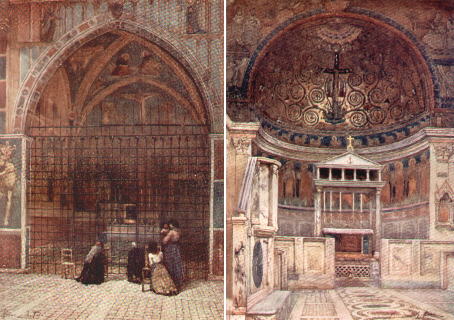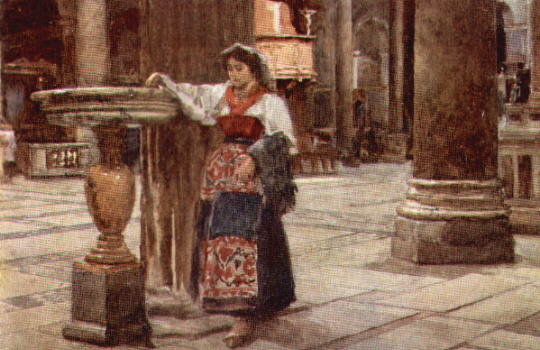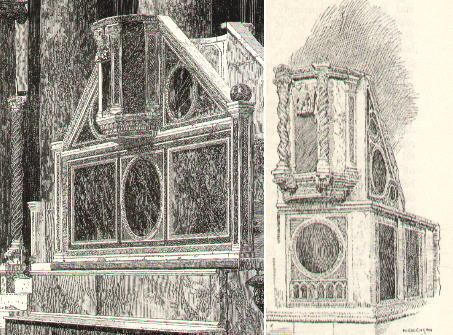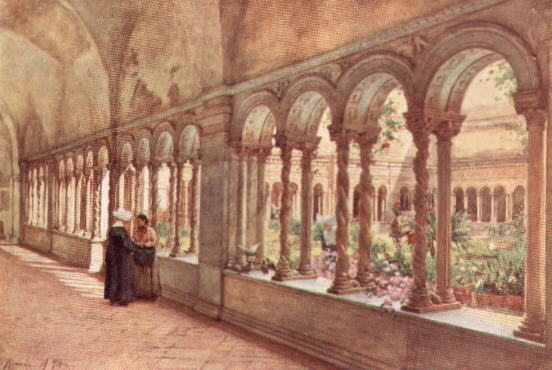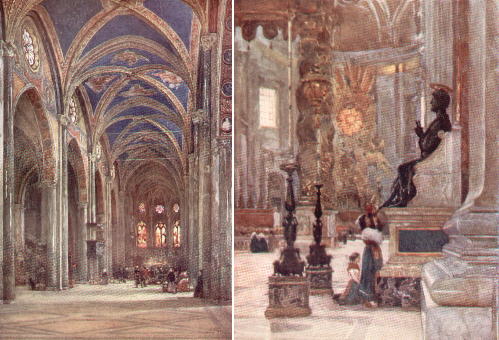  seen by a 1905 armchair traveller Interiors of Churches
In 1908 William Dean Howells made the following comment in Roman Holidays and Others:
The attention of Pisa focused on the most ancient churches of Rome and especially on those which for being outside the center of Papal Rome had been less touched by later modifications and refurbishments. S. Maria in Cosmedin, with its Cosmati pavement and without chapels crammed with paintings and statues, offered Pisa the opportunity to show an interior which reminded the viewer of the simplicity of Northern Europe churches. By portraying a lonely woman in prayer he suggested that direct relationship between the believer and God which his readers were likely to appreciate. The golden mosaics of Cappella di S. Zenone were evocative of Constantinople, a city which was very much in fashion in the early XXth century and which was seen as a very exotic location: this may explain why they were selected by Pisa.
S. Clemente is a church which truly offers works of art of all periods, including IIIrd century paintings portraying Mithraic rites. Pisa selected Cappella del Paradiso, with paintings by Masolino and Masaccio, and the apse with its fine mosaics.
Are Romans more devout because of the religious role of their city? In general travellers, writers and historians came to the conclusion that no, they are not more devout: they rather found Romans to be cynical in their participation to religious ceremonies. However the people of the Campagna, the Roman countryside, were thought to be more sincere in their behaviour. Pisa chose to portray a young peasant in her Sunday dress in the empty interior of S. Maria in Aracoeli. The painting calls the attention of the viewer to the stone below the column: the church was built making use of columns coming from different Roman buildings and it was necessary to adjust them to the same height either by cutting their edges or by putting a stone below them.
The interest for the works of the Cosmati was not limited to Pisa. Other illustrators of books on Rome showed ambos decorated by the Cosmati.
Pisa was prepared to make use of his artist's licence to portray a moving scene: in the beautiful cloister of S. Paolo fuori le Mura a nun is comforting a young woman while another nun is doing some gardening. It is a pretty scene but unlikely to have actually occurred. S. Paolo is run by friars and obviously while nuns can surely visit the cloister it is hard to believe there would not be a friar around.
S. Maria sopra Minerva is the only Gothic church of Rome and this explains why Pisa chose to show it to the readers of his book. You cannot say you have been in Rome unless you have seen at least the Colosseum and St. Peter's: this is true today for those who are on a cruise in the Mediterranean Sea and land in Civitavecchia for a half a day excursion to Rome and it was true as well for 1905 armchair travellers: this explains why Pisa painted a view of the interior of St. Peter's, letting his readers catch a glimpse of that Baroque art they were assumed to abhor so much. One of the women in prayer is shown while she is touching the foot of the bronze statue of St. Peter: a gesture repeated by millions of pilgrims (by the way there are copies of this statue around the world: in London in the Brompton Oratory, in Paris in Notre Dame des Victoires). Other pages of this section: Roman Forum, Roma Sparita, Tivoli and Subiaco. |
All images © 1999 - 2004 by Roberto Piperno. Write to romapip@quipo.it
